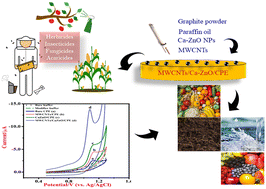Improved electrochemical detection of harmful 1-NAA molecules by a MWNTs/Ca–ZnO nanocomposite-modified paste electrode
Abstract
The electrochemical degradation of 1-naphthaleneacetic acid (1-NAA) was studied using multiwalled carbon nanotubes (MWNTs) and calcium-doped zinc oxide (Ca–ZnO) nanoparticles embedded in carbon paste electrodes (CPEs). Samples of water, fruits, soil, and vegetables were accurately analyzed using the square wave voltammetry (SWV) technique. Using cyclic voltammetry (CV) and SWV methods, we investigated the impact of various factors on 1-NAA. The sensor displayed exceptional catalytic properties and peak current in a pH 3.0 0.2 M phosphate buffer (PB) solution. The peak currents for the bare CPE (BCPE), MWNTs/CPE, Ca-doped ZnO/CPE, and MWNTs/Ca–ZnO/CPE were 2.53 μA, 4.42 μA, 5.96 μA, and 13.78 μA, respectively. Similarly, the peak potentials for BCPE, MWNTs/CPE, Ca-doped ZnO/CPE, and MWNTs/Ca–ZnO/CPE were measured to be 1.127 V, 1.131 V, 1.126 V, and 1.081 V, respectively. Electrokinetic parameters like temperature and the heterogeneous rate constant, as well as the scan rate, pH, accumulation time, the energy of activation, transfer coefficient, and electron involvement, were examined in the electrochemical oxidation of 1-NAA. So the detection and quantification limits for the 1-NAA molecule are 0.025 nM and 0.084 nM.



 Please wait while we load your content...
Please wait while we load your content...